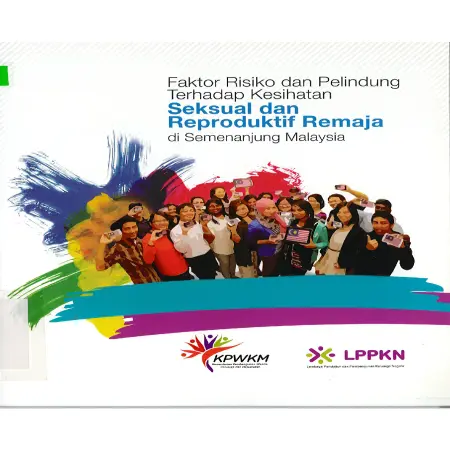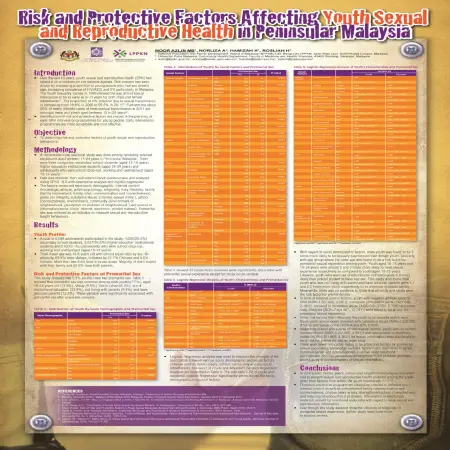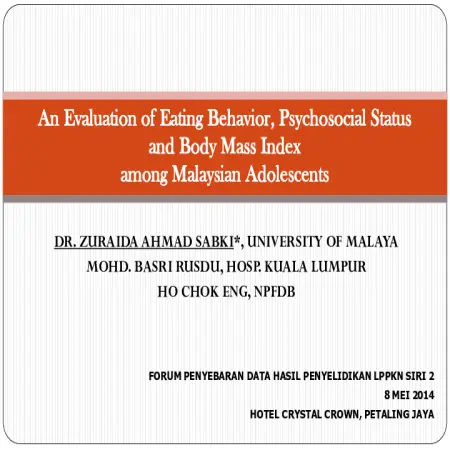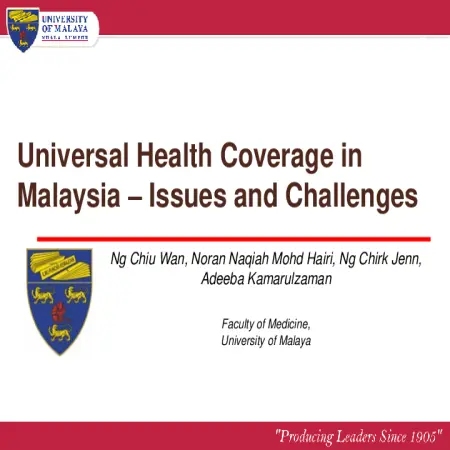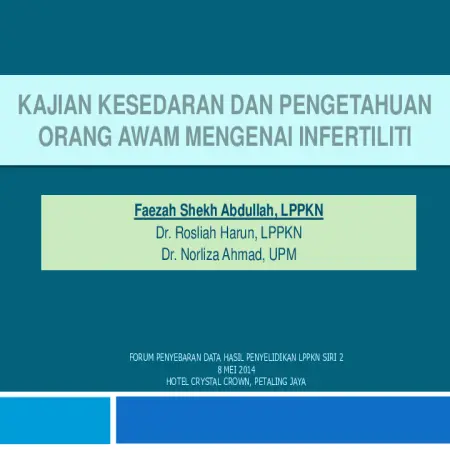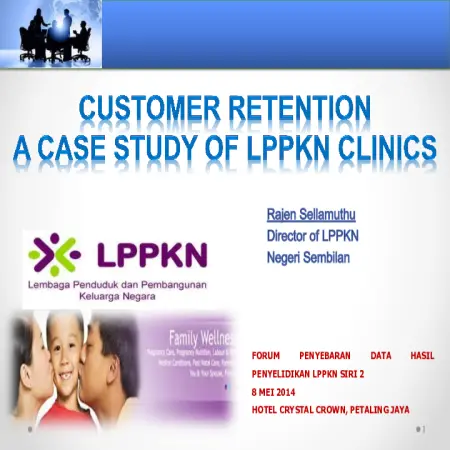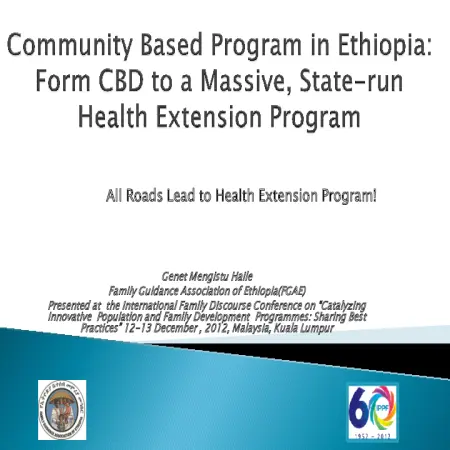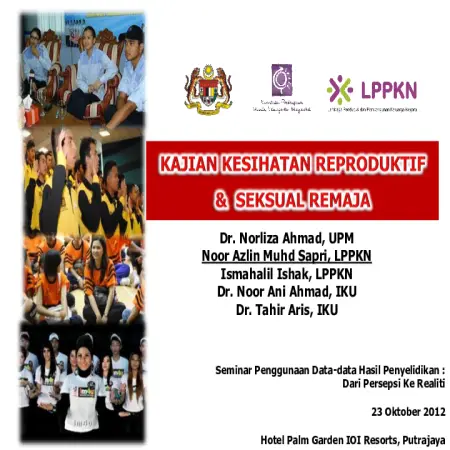TOPICS
Results for Topics : "Health"
|
|
Faktor risiko dan pelindung terhadap kesihatan seksual dan reproduktif remaja di Semenanjung Malaysia
Item Type: Research Report
Editor:
Year: 00/00/2015
Abstract: In Malaysia, statistics from the National Registration Department (NRD) show that a total of 214,033 illegitimate children were born from 2004 to 2009. While statistics from the Royal Malaysia Police (RMP) show that 596 cases of baby abandonment were reported from 2005 to 2013. For the total number of rape crimes in among teenagers under the age of 18, PDRM statistics show an increase from 1,710 cases in 2006 to 2,658 cases in 2013. The increase in such cases shows that today's teenagers face the problem of moral decay and fragility of identity which is a concern of Malaysian society. Accordingly, knowledge of sexual and reproductive health can help adolescents avoid negative symptoms such as cases of extramarital pregnancies and social symptoms related to sexuality. The objective of this study was to (i). to study the prevalence of unhealthy sexual behavior among adolescents aged 13-24 years in peninsular Malaysia; (ii). identify risk factors related to adolescent sexual and reproductive health (ASRH); and (iii). identify protective factors related to ASRH. This study was implemented using two (2) main approaches, namely quantitative and qualitative methods. The design of the quantitative study was successfully conducted on 5,088 adolescents aged 13 to 24 years. The qualitative study involved a total of eight (8) Focus Group Discussions (FGD) conducted in eight (8) selected detention centers and shelter hostels located in several states in Peninsular Malaysia.
|
|
|
|
|
|
Risk and protective factors affecting youth sexual and reproductive health in Peninsular Malaysia
Item Type: Scientific Poster
Editor:
Year: 00/01/2014
Abstract: Over the last 10 years, youth sexual and reproductive health (SRH) had raised a lot of concern on the national agenda. This concern has been driven by increasing proportion of young people who had sex at early age, increasing prevalence of HIV/AIDS and STI particularly in Malaysia.
|
|
|
|
|
|
An evaluation of eating behavior, psychosocial status and body mass index among Malaysian adolescents
Item Type: Conference or Workshop Item
Editor:
Year: 00/00/2014
Abstract: This study is an attempt to produce an abbreviated Malay version of Weight and Lifestyle Inventory (MWALI), as an evaluation tool to assess eating and related bio-psychosocial factors among adolescents attending kafe@TEEN, Kuala Lumpur. The MWALI was translated ‘forward–backward’ from English to Malay and then administered to 135 adolescents to assess the factor construct of the eating behaviour and its relationships with the demographic profile, dysphoria, global self-esteem and body mass index (BMI). The exploratory factor analysis of the eating behaviour yielded five factors are Negative Emotion, Poor Impulse Control, Social Cues, Snacking and Early Meals in relation to over-eating which were significantly and positively correlated with BMI. Eating in response to Social Cues was negatively correlated with self-esteem, overeating at Early Meals was positively correlated with dysphoria. Female has significantly higher mean score of eating in response to Negative Emotion and eating in response to Social Cues. MWALI is appropriate for assessing eating behaviour and associated bio-psychosocial factors among overweight and obese adolescents in the primary care setting in Malaysia.
|
|
|
|
|
|
Risk and protective factors affecting adolescent youth sexual and reproductive health in Peninsular Malaysia
Item Type: Conference or Workshop Item
Editor:
Year: 00/00/2014
Abstract: This study shows that over the last 10 years, youth sexual and reproductive health (SRH) had raised a lot of concern on the national agenda. According to the statistics, age at first sexual intercourse to be as early as 9-10 years for both male and female adolescents (The Youth Sexuality Survey, 1996). The proportion of HIV infection due to sexual transmission is increasing from 18.8 % in 2000 to 55.5 % in 2011. About 26 % of newly infected cases of heterosexual transmission in 2011 are among teens and youth aged between 13 to 29 years. This study is to determine the prevalence of SRH behaviours of adolescent/youth and to identify risk and protective factors that influence adolescent/youth sexual reproductive health in Peninsular Malaysia.
|
|
|
|
|
|
Universal health coverage in Malaysia: issues and challenges
Item Type: Conference or Workshop Item
Editor:
Year: 00/00/2014
Abstract: Socioeconomic development in Malaysia, over the past few decades, has led to the improvement and expansion of the public healthcare system. This system has provided universal access to a low-priced package of comprehensive health care leading Malaysia to claim to have achieved universal health coverage (UHC). However, the Malaysian health landscape is changing rapidly. Provision of private care has grown especially in large urban towns, mainly in response to public demand. Thus far, private care has been predominantly bought and utilised by the rich but because of differentials in quality of care between the public and private sector, unabated expansion of the private health sector has the potential to adversely affect universal access to care. This effect may be accentuated in the coming years by demographic changes in the country specifically by the ageing of the population. This paper is intended to highlight challenges to UHC in Malaysia in the face of the changing health landscape in the country and to offer some suggestions as to how these challenges can be met.
|
|
|
|
|
|
Kajian kesedaran dan pengetahuan orang awam mengenai infertiliti
Item Type: Conference or Workshop Item
Editor:
Year: 00/00/2014
Abstract: The infertility rate in Malaysia is estimated around 10 to 15 %. World Health Organization has classified infertility as a disease that needs attention as early as possible. It is one of the factors that contribute to decreasing total fertility rate. Public misunderstanding regarding infertility may affect on how they handle this issue. People always take this issue lightly since it is not a life-threatening disease, unlike heart attack, diabetes and cancer. The Bertarelli Foundation Scientific Board (1999) had found that infertility awareness was still low in a few countries in Europe, such as Belgium, Italy, France, Germany, Sweden and United Kingdom. Knowledge on infertility is very crucial because it helps couples to prepare when they are having difficulty in conceiving. The objective of this study was to identify our local people awareness and knowledge on infertility issues as very few studies have been done in Malaysia.
|
|
|
|
|
|
Customer retention: a case study of LPPKN clinical services
Item Type: Conference or Workshop Item
Editor:
Year: 00/00/2014
Abstract: This is a descriptive study intended to identify the main factors which contribute to the customer retention among the “Clinical Clients” of National Population and Family Development Board or LPPKN. The study focused on three variables to check on the level of influence, affect and effect to the process of customer retention. Those variables are service branding, perceived value and service quality. The study also covered the impact and influence of the demographic element to the service branding, perceived value and service quality in the process of customer retention. This study was conducted at the LPPKN Clinics in Klang Valley and Seremban. Understanding and fulfilling the customers need will contribute to retaining existing customers and reduce the customer switching intentions. The research findings show there is a positive relationship between perceived value and service quality with customer retention. Nevertheless relationship between service branding and customer retention is not supported for the LPPKN clinical setting. Analysis on the demographic factor showed that, it has a significant influence in regard to service branding, perceived value, services quality and customer retention. The output of the study will be helpful to managers and marketers of the clinical service to understand the customer needs, priority and expectations. Furthermore the findings of the research will enable the managers and policy makers to take necessary actions in their marketing and operational planning to stay competitive and maintain a stable income for a long term. This study will also help LPPKN Clinics to improve service quality, increase number of clinical clients, facilitate the process of customer retention and in long term improve financial performance.
|
|
|
|
|
|
Antara dua dunia : memahami pengalaman subjektif transeksual
Item Type: Thesis
Editor:
Year: 00/00/2013
Abstract: This study was designed to make a better understanding of transsexual’s subjective experiences. Semi structure face to face interview method was chosen in order to gather these data. There are three respondent (transsexual male to female) aged 30th , 40th
and 50th involved in this study, which was represented by one person for each group. The data gathered was analyzed based on topics and subtopics. Three (3) main topic such as background, experience in childhood and adolescent and self-concept was highlighted in
this study. There are numbers of interesting findings based on background, trigger that cause transsexual identity, colleague influential, emotion and behavior. These key elements should be considered directly or indirectly in order to implement policy, intervention, program and counseling. By understanding their experience well, would help enhancing their resilient and coping skills with regards to immoral activities and make them feel part of the community. This study is a prelude to other studies involving the transsexual especially for parents who have child which is tend to develop transsexual identity and other aspects such as sexual life, psychology resiliency, coping skills and ets.
|
|
|
|
|
|
Community based program in Ethiopia: from CBD to massive, state-run health extension program
Item Type: Conference or Workshop Item
Editor:
Year: 00/00/2012
Abstract: The Family Guidance Association of Ethiopia (FGAE) pioneered a Community-based FP Distribution [CBD] program in Ethiopia in 1991. The CBD agents were selected by the community members through prior set selection criteria including interest and willingness to volunteer for community work and sufficient knowledge about the socio-economic and cultural context of the community. The CBD program was very widely replicated by many other institutions as a low cost, effective strategy to increase access to modern contraceptive services in under-served communities. Considering the challenges related to distance and access to fixed health facilities among women with high unmet needs and the lessons drawn from project based success stories of the CBD programs, the government of Ethiopia initiated the Health Extension Program (HEP) in 2003 to accelerate utilization of primary health care services in rural communities. The HEP is implemented by trained health extension workers or practitioners at the community level with strong focus on health promotion and disease prevention and empowering community members to make decisions and take actions on their own health. The Health Extension Workers (HEW) were recruited from the community among those who completed high school and trained for one year. Currently, two female HEWs are assigned at each kebele (the lowest administrative unit) and to implement a package of 16 primary health care services including FP and maternal health. A total of about 35,000 rural HEWs and 4,800 urban Health Extension Professionals [Graduate Nurses] are deployed by MoH as government employees throughout the country. The program has created a better opportunity, particularly for rural women and young people to access health services including FP/RH.
|
|
|
|
|
|
Kajian kesihatan reproduktif & seksual remaja
Item Type: Conference or Workshop Item
Editor:
Year: 00/00/2012
Abstract: The increase in reproductive and social health issues among adolescents has been hotly debated both nationally and internationally. Every day, Malaysians are presented with news on adolescent misconduct, especially those involving cases of abortion and out -of -wedlock pregnancies. Therefore, a specific study to look at the level of reproductive and sexual health of adolescents and the factors that influence it was conducted based on the results of the national level of adolescent health research. Methodology this cross -sectional study was conducted in 2010 using secondary data from the Adolescent Health Screening Form (BSSK/R/1/2008) which was filled by trainees of the National Service Training Program (NSTP) in 80 NSTP camps throughout the country. To achieve the objectives of the study, the analysis used is descriptive analysis, chi -square test and logistic regression using SPSS software. The parameters studied included socio-demographic characteristics (gender, age, ethnicity and level of education) and social characteristics (risky behavior, history of abuse, anti-social behavior, substance abuse, religion, and family relationships). While there are nine (9) SRH issues that were studied, namely masturbation, watching pornography, extramarital sex, multi -partner sex, STIs, homosexual tendencies, homosexual relationships, pregnancy and abortion. Results A total of 23,231 data were analyzed. Of these, a total of 22,750 respondents aged 18-24 years were screened for the purpose of study analysis. The results of the analysis showed that the issue of watching and reading pornographic material among adolescents recorded the highest percentage (39.5%) followed by masturbation (28.5%) and extramarital sex (6.5%). All socio -demographic factors studied had a significant relationship with extramarital sex, homosexual predisposition and abortion (p <0.05). Risk factors for extramarital sex are the age group of 20-24 years (OR = 2.710, SK95% 1.967, 3.759), risky behavior (OR = 30.495 SK95% 19.683, 47.427), involvement in substance abuse (OR = 12.33 SK95% 8,051, 18,891), anti-social (OR = 2,615 SK95% 2,206, 3,100) and ever abused (OR = 1,726 SK95% 1,389, 2,145). While the appreciation of religion is a protective factor for adolescents where the study found that adolescents who appreciate religion are twice as likely to have sex compared to adolescents who do not appreciate religion. There is no evidence to suggest that familial relationship variables influence adolescents to have sex. Conclusion overall it can be concluded that adolescent reproductive and sexual health issues need to be given serious attention. This is because the results of the study show that the trend of extramarital sex among adolescents which is a key indicator of the level of adolescent reproductive and sexual health issues has increased from 2.2% in 2004 (MPFS-4) to 6.5% in 2010. Therefore, multisectoral cooperation programs are needed to address this issue. The implementation of intervention programs should also be focused on high-risk adolescents such as having risky behaviors, anti-social and involved in cases of substance abuse. The planning and preparation of the program must also take into account the concepts and teachings of religion practiced in Malaysia through an approach that can be accepted by adolescents. Further studies need to be conducted more extensively taking into account other factors that have yet to be explored.
|
|
|
|





